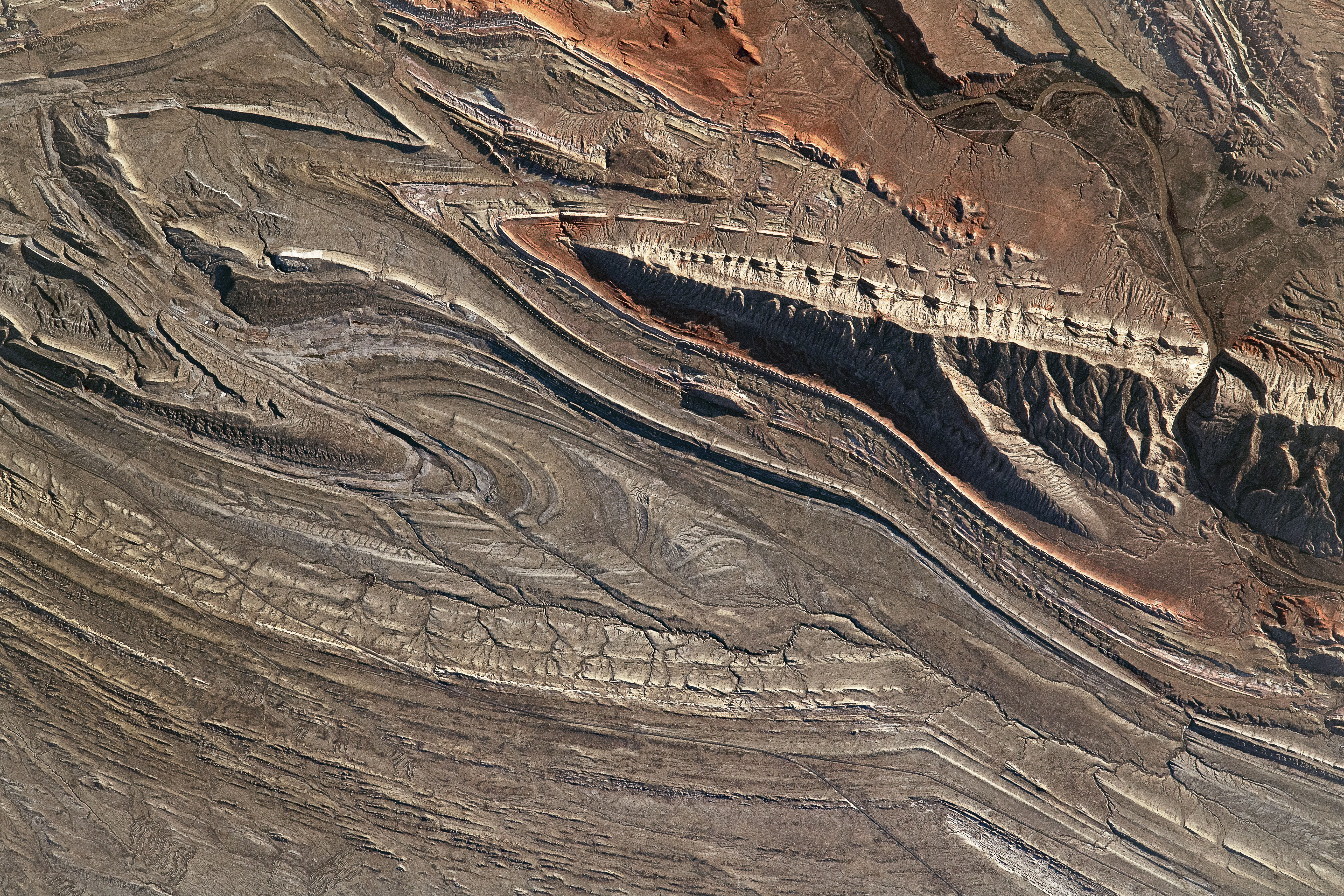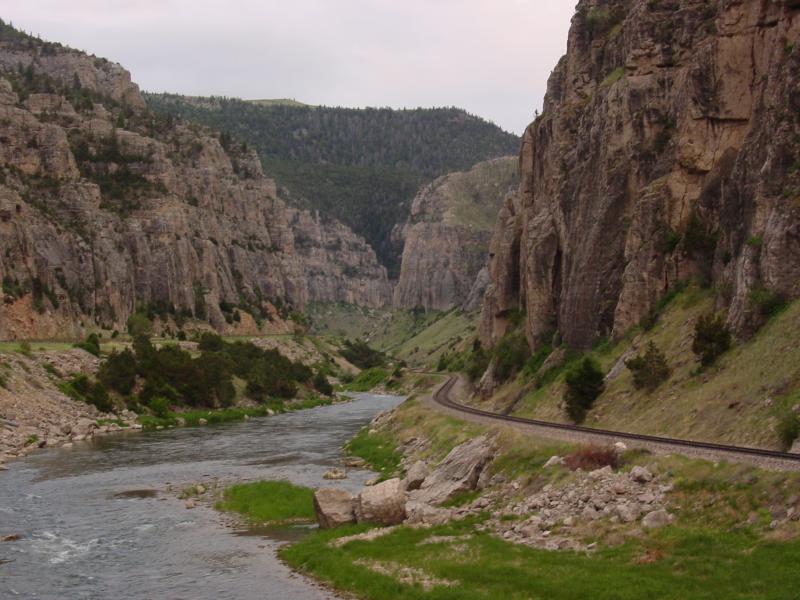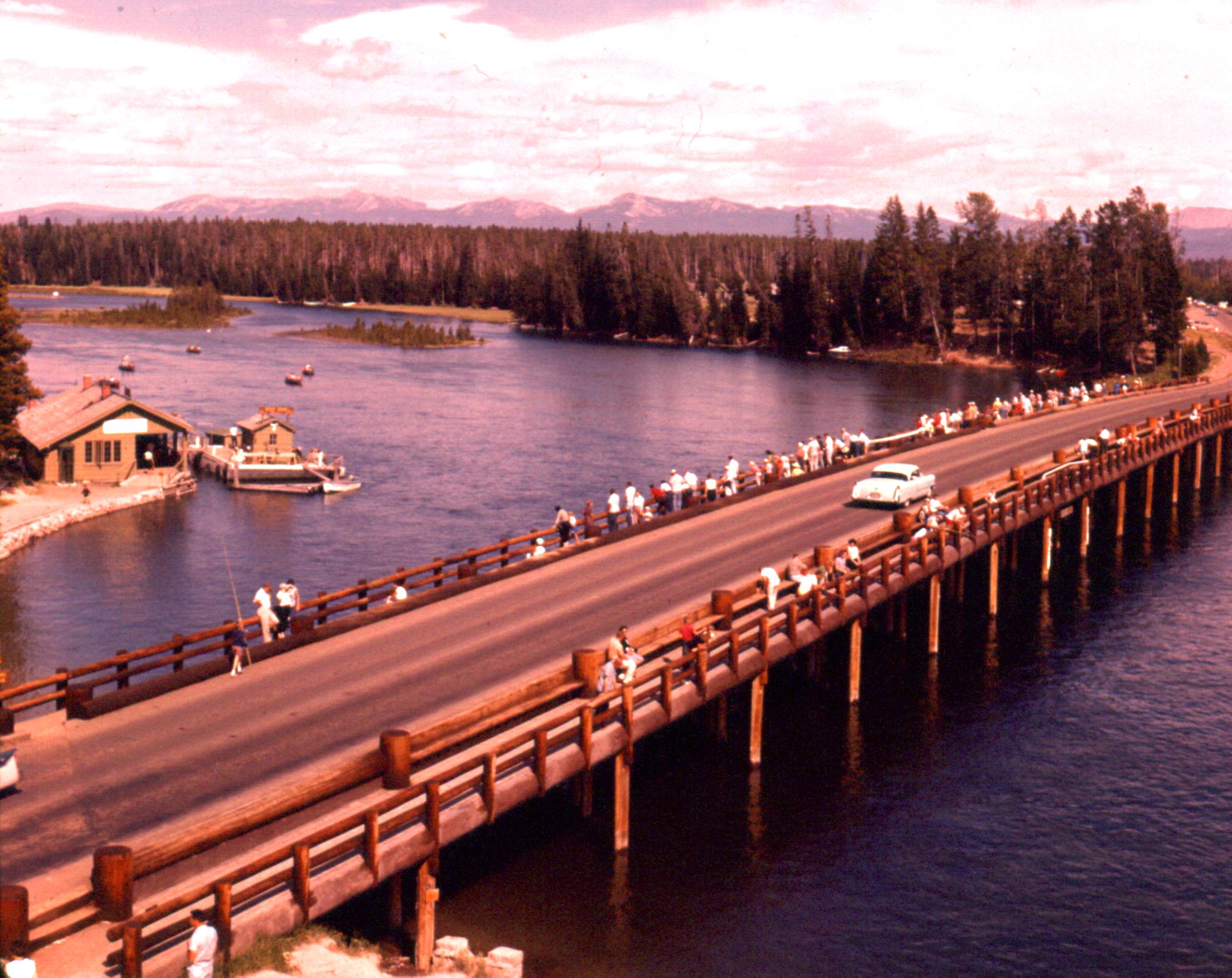|
Big Horn River
The Bighorn River is a tributary of the Yellowstone, approximately long, in the states of Wyoming and Montana in the western United States. The river was named in 1805 by fur trader François Larocque for the bighorn sheep he saw along its banks as he explored the Yellowstone. The upper reaches of the Bighorn, south of the Owl Creek Mountains in Wyoming, are known as the Wind River. The two rivers are sometimes referred to as the Wind/Bighorn. The Wind River officially becomes the Bighorn River at the Wedding of the Waters, on the north side of the Wind River Canyon near the town of Thermopolis. From there, the river flows through the Bighorn Basin in north central Wyoming, passing through Thermopolis and Hot Springs State Park. At the border with Montana, the river turns northeast, and flows past the north end of the Bighorn Mountains, through the Crow Indian Reservation, where the Yellowtail Dam forms the Bighorn Lake reservoir. The reservoir and the surrounding canyo ... [...More Info...] [...Related Items...] OR: [Wikipedia] [Google] [Baidu] |
CQA Four Mile Bridge
The CQA Four Mile Bridge spans the Big Horn River in Hot Springs County, Wyoming. The bridge was erected in 1927-28 by the Charles M. Smith Company and spans with a total length of . The rigid 7-panel truss bridge, Pennsylvania through-truss was nominated for inclusion on the National Register of Historic Places as one of forty bridges throughout Wyoming that collectively illustrate steel truss construction, a technique of bridge design that has become obsolete since the mid-twentieth century. The bridge rests on concrete piers and abutments and is approached by two Warren pony trusses. The Four Mile Bridge was placed on the National Register of Historic Places in 1985. See also *List of bridges documented by the Historic American Engineering Record in Wyoming References External links * at the National Park Service's NRHP database *Four Mile Bridge at the Wyoming State Historic Preservation Office Buildings and structures in Hot Springs County, Wyoming Road bridges on ... [...More Info...] [...Related Items...] OR: [Wikipedia] [Google] [Baidu] |
Greybull, Wyoming
Greybull is a town in central Big Horn County, Wyoming, United States. The population was 1,651 at the 2020 census. Geography According to the United States Census Bureau, the town has a total area of , of which is land and is water. Climate According to the Köppen Climate Classification system, Greybull has a cold semi-arid climate, abbreviated "BSk" on climate maps. The hottest temperature recorded in Greybull was on June 30, 2010, and July 17, 2010, while the coldest temperature recorded was on February 2, 1996. Demographics 2010 census As of the census of 2010, there were 1,847 people, 778 households, and 488 families living in the town. The population density was . There were 879 housing units at an average density of . The racial makeup of the town was 92.9% White, 0.4% African American, 1.1% Native American, 0.2% Asian, 0.1% Pacific Islander, 4.5% from other races, and 0.9% from two or more races. Hispanic or Latino of any race were 10.7% of the population ... [...More Info...] [...Related Items...] OR: [Wikipedia] [Google] [Baidu] |
Hot Springs State Park
Hot Springs State Park is a public recreation area in Thermopolis, Wyoming, known for its hot springs, which flow at a constant temperature of . The state park offers free bathing at the State Bath House, where temperatures are moderated to a therapeutic . The petroglyph site at Legend Rock, some away, is also part of the park. The park is managed by the Wyoming Division of State Parks and Historic Sites. History The land on which the state park sits was a cession agreement, and the ceded portion was purchased from the Eastern Shoshone by the federal government in 1896, when Indian Inspector James McLaughlin negotiated a purchase price of $60,000 for a of the Shoshone reservation. A of that land was released to the state in 1897 which became Wyoming's first state park, known as Big Horn Hot Springs State Reserve. A small herd of bison was established in 1916. Features Designated as the State Bison Herd, the number of bison is maintained at 15 due to the carrying capacity ... [...More Info...] [...Related Items...] OR: [Wikipedia] [Google] [Baidu] |
Bighorn Basin
The Bighorn Basin is a plateau region and intermontane basin, approximately 100 miles (160 km) wide, in north-central Wyoming in the United States. It is bounded by the Absaroka Range on the west, the Pryor Mountains on the north, the Bighorn Mountains on the east, and the Owl Creek Mountains and Bridger Mountains (Wyoming), Bridger Mountains on the south. It is drained to the north by tributaries of the Bighorn River, which enters the basin from the south, through a gap between the Owl Creek and Bridger Mountains, as the Wind River (Wyoming), Wind River, and becomes the Bighorn as it enters the basin. The region is semi-arid, receiving only 6–10 in (15–25 cm) of rain annually. The largest cities in the basin include the Wyoming towns of Cody, Wyoming, Cody, Thermopolis, Wyoming, Thermopolis, Worland, Wyoming, Worland, and Powell, Wyoming, Powell. Sugar beets, pinto beans, sunflowers, barley, oats, corn and alfalfa hay are grown on irrigated farms in the region. H ... [...More Info...] [...Related Items...] OR: [Wikipedia] [Google] [Baidu] |
Wedding Of The Waters, Wyoming
Thermopolis is the county seat and most populous town in Hot Springs County, Wyoming, United States. As of the 2020 U.S. Census, the town population was 2,725. Thermopolis, Greek for "hot city", is home to numerous natural hot springs, in which mineral-laden waters are heated by geothermal processes. The town is named for the hot springs located there. The town claims the world's largest mineral hot spring, appropriately named "The Big Spring", as part of Hot Springs State Park. The springs are open to the public for free as part of an 1896 treaty signed with the Shoshone and Arapaho Indian tribes. Dinosaur fossils were found on the Warm Springs Ranch in 1993, and the Wyoming Dinosaur Center was founded soon after. Geography Thermopolis is located near the northern end of the Wind River Canyon and Wedding of the Waters, where the north-flowing Wind River becomes the Bighorn River. It is an unusual instance of a river changing names at a point other than a confluence of two s ... [...More Info...] [...Related Items...] OR: [Wikipedia] [Google] [Baidu] |
Wind River (Wyoming)
The Wind River is the name applied to the upper reaches of the Bighorn River in Wyoming in the United States. The Wind River is long. The two rivers are sometimes referred to as the Wind/Bighorn. Course Its headwaters are at Wind River Lake in the Rocky Mountains, near the summit of Togwotee Pass (pronounced TOH-guh-tee) and gathers water from several forks along the northeast side of the Wind River Range in west central Wyoming. It flows southeastward, across the Wind River Basin and the Wind River Indian Reservation and joins the Little Wind River near Riverton. Up stream from this confluence, it is known locally as the Big Wind River. It flows northward, through a gap in the Owl Creek Mountains, where the name of the river becomes the Bighorn River. In the Owl Creek Mountains, it is dammed to form Boysen Reservoir Boysen Reservoir is a reservoir formed by Boysen Dam, an earth-fill dam on the Wind River (Wyoming), Wind River in the central part of the U.S. state ... [...More Info...] [...Related Items...] OR: [Wikipedia] [Google] [Baidu] |
Owl Creek Mountains
The Owl Creek Mountains are a subrange of the Rocky Mountains in central Wyoming in the United States, running east to west to form a bridge between the Absaroka Range to the northwest and the Bridger Mountains to the east. The range forms the boundary between the Bighorn Basin to the north and the Shoshone Basin to the south. The Wind River passes through the gap between the range and the Bridger Mountains to the east, and becomes the Bighorn River on the north side of the mountains. The high point of the range is . The range is entirely within the Wind River Indian Reservation. Geology During the Tertiary period, the rivers in the region removed much of the basin fill exposing older bedrock. The rocks in the Owl Creek Range date from the Mississippian age through the Cretaceous period. The mountains likely emerged in the late Cretaceous, in the Laramide orogeny. In areas near the Boysen Fault, just north of Boysen Reservoir's dam at the southern mouth of Wind River Canyon ... [...More Info...] [...Related Items...] OR: [Wikipedia] [Google] [Baidu] |
Bighorn Sheep
The bighorn sheep (''Ovis canadensis'') is a species of Ovis, sheep native to North America. It is named for its large Horn (anatomy), horns. A pair of horns may weigh up to ; the sheep typically weigh up to . Recent genetic testing indicates three distinct subspecies of ''Ovis canadensis'', one of which is endangered: Sierra Nevada bighorn sheep, ''O. c. sierrae''. Sheep originally crossed to North America over the Beringia, Bering Land Bridge from Siberia; the population in North America peaked in the millions, and the bighorn sheep entered into the mythology of Indigenous peoples of the Americas, Native Americans. By 1900, the population had crashed to several thousand due to diseases introduced through European livestock and overhunting. Taxonomy and genetics ''Ovis canadensis'' is one of two species of mountain Ovis, sheep in North America; the other species being ''O. dalli'', the Dall sheep. Wild sheep crossed the Bering land bridge from Siberia into Alaska during the Pl ... [...More Info...] [...Related Items...] OR: [Wikipedia] [Google] [Baidu] |
Tributary
A tributary, or an ''affluent'', is a stream or river that flows into a larger stream (''main stem'' or ''"parent"''), river, or a lake. A tributary does not flow directly into a sea or ocean. Tributaries, and the main stem river into which they flow, drain the surrounding drainage basin of its surface water and groundwater, leading the water out into an ocean, another river, or into an endorheic basin. The Irtysh is a chief tributary of the Ob (river), Ob river and is also the longest tributary river in the world with a length of . The Madeira River is the largest tributary river by volume in the world with an average discharge of . A confluence, where two or more bodies of water meet, usually refers to the joining of tributaries. The opposite to a tributary is a distributary, a river or stream that branches off from and flows away from the main stream. [...More Info...] [...Related Items...] OR: [Wikipedia] [Google] [Baidu] |
Yellowstone County, Montana
Yellowstone County is the most populous county in the U.S. state of Montana. As of the 2020 census, the population was 164,731. Its county seat is Billings, the state's most populous city. Like the nearby national park, Yellowstone County is named after the Yellowstone River which roughly bisects the county, flowing southwest to northeast. The river, in turn, was named for the yellow sandstone cliffs in what is now Yellowstone County. Yellowstone County is included in the Billings, Montana Metropolitan Statistical Area. Geography According to the United States Census Bureau, the county has a total area of , of which is land and (0.6%) is water. Major highways * * * * * * * * * Transit * Billings Metropolitan Transit *Express Arrow *Jefferson Lines Adjacent counties * Musselshell County – north * Rosebud County – northeast * Treasure County – east * Big Horn County – southeast * Carbon County – southwest * Stillwater County – west * Golden Valle ... [...More Info...] [...Related Items...] OR: [Wikipedia] [Google] [Baidu] |
Yellowstone River
The Yellowstone River is a tributary of the Missouri River, approximately long, in the Western United States. Considered the principal tributary of the upper Missouri, via its own tributaries it drains an area with headwaters across the mountains and Great Plains, high plains of southern Montana and northern Wyoming, and stretching east from the Rocky Mountains in the vicinity of Yellowstone National Park. It flows northeast to its confluence with the Missouri River on the North Dakota side of the border, about west of Williston, North Dakota, Williston. Etymology The name is widely believed to have been derived from the Hidatsa, Minnetaree Indian name ''Mi tse a-da-zi'' (Yellow Rock River) (Hidatsa language, Hidatsa: ''miʔciiʔriaashiish). Common lore recounts that the name was inspired by the yellow-colored rocks along the Grand Canyon of the Yellowstone, but the Minnetaree never lived along the upper stretches of the Yellowstone. Some scholars think that the river was inst ... [...More Info...] [...Related Items...] OR: [Wikipedia] [Google] [Baidu] |
Teton County, Wyoming
Teton County is a County (United States), county in the U.S. state of Wyoming. As of the 2020 United States census, the population was 23,331. Its county seat is Jackson, Wyoming, Jackson. Its west boundary line is also the Wyoming state boundary shared with Idaho and the southern tip of Montana. Teton County is part of the Jackson, WY-Idaho, ID Jackson, Wyoming micropolitan area, Micropolitan Statistical Area. Teton County contains the Jackson Hole ski area, all of Grand Teton National Park, and 40.4% of Yellowstone National Park's total area, including over 96.6% of its water area (largely in Yellowstone Lake). History Teton County was created February 15, 1921, from a portion of Lincoln County, Wyoming, Lincoln County. Its governing organization was completed in 1922. The county was named for the Teton Range. The county was created because the inhabitants lived too far away from Kemmerer, Wyoming, Kemmerer, the county seat of Lincoln County, Wyoming, Lincoln County. The creat ... [...More Info...] [...Related Items...] OR: [Wikipedia] [Google] [Baidu] |




